Mobile River snakes are a diverse and important part of the region’s ecosystem. Reptiles like cottonmouths, copperheads, pigmy rattlesnakes, crowned snakes, garter snakes, and many others can be found within the Mobile-Tensaw River Delta. These species exhibit unique behaviors that allow them to thrive in wetland ecosystems, such as their diet and size.
Additionally, they can vary in venom and danger levels when provoked. It’s important to note that despite their sometimes intimidating appearance, these snakes are essential for balancing the local environment. Therefore, it’s important to show them respect and appreciation if spotted in the wild. This guide will explore all you need to know about the fascinating snakes of Mobile River.
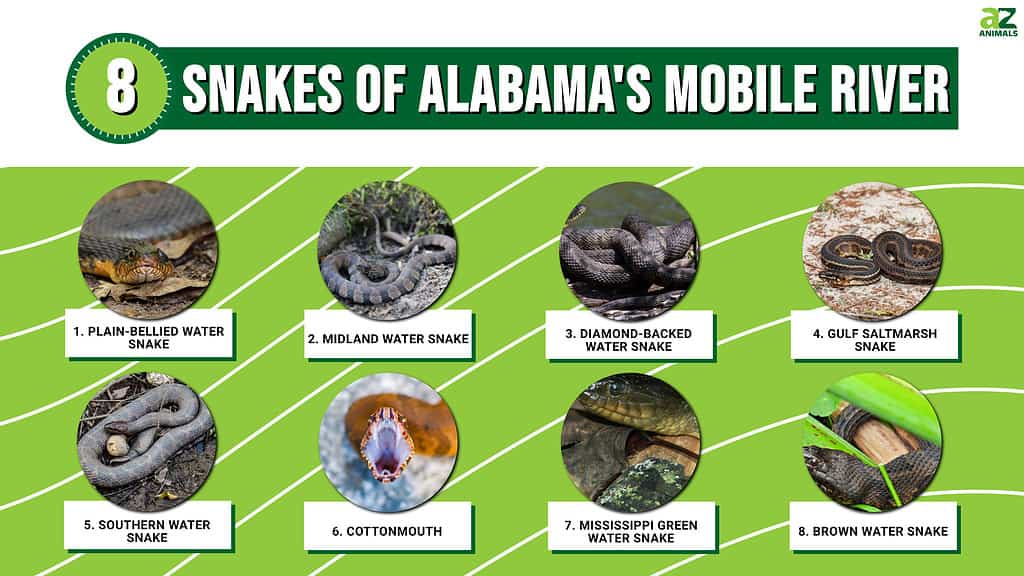
1. Plain-Bellied Water Snake
Scientific name: Nerodia erythrogaster
The plain-bellied water snake is noticeably large, thick-bodied, and semi-aquatic. There are 5 subspecies of the snake in North America, with Alabama being home to 2: the yellow-bellied water snakes (Nerodia erythrogaster flavigaster) and the redbelly water snakes (Nerodia erythrogaster erythrogaster).
N. erythrogaster flavigaster’s populace is flippantly allotted throughout the kingdom. The snake is generally 30 to forty inches long but can grow as much as 5 feet. It has a greenish-gray top and is yellowish underneath. Its scales are keeled, and the young have distinct coloration that fades over time.
N. erythrogaster is typically confined to the extreme southeastern counties and is generally similar in size to its yellowbelly relative. The snake has a brownish top coloration with a plain-red or orange-red belly. Both species’ bellies are unmarked, distinguishing them from other water snake species in their genus.
The plain-bellied water snake is often seen basking on rocks or overhanging branches near permanent water bodies such as rivers, streams, and lakes. The snake can wander far from the water during hot, humid weather.
Plainbelly water snakes are excellent swimmers and often hunt in the water. Their diet includes fish, crayfish, frogs, and salamanders. They mate in spring and early summer, with live births in August through October.
N. erythrogaster is non-venomous and poses no significant danger to humans. It will flee or try to hide rather than confront the attacker. However, the snake will bite hard and repeatedly when threatened or provoked.

2. Midland Water Snake
Scientific name: Nerodia sipedon pleuralis
The midland water species is interspecies of the more common Nerodia sipedon (northern water snake.) The snake is common statewide in Alabama and is a conspicuous inhabitant of ponds, rivers, and lakes. It is the most commonly encountered water snake in the northern two-thirds of Alabama. The state’s Department of Conservation & Natural Resources classifies it under Lowest Conservation Concern.
The midland water snake is a medium-sized snake with adults measuring 24 to 42 inches. Newborn snakes are roughly 7.5 inches long. It has a brown or grayish-brown back and sides, with numerous dark blotches. The spots can be black, brown, or reddish.
Its belly is yellow or cream-colored, with dark markings. Males are typically smaller than females. The scales are keeled, and the anal plate is divided. The snake can be seen basking on emergent vegetation or rocks during hot days.
The midland water species is an opportunistic feeder with a wide range of prey. Its diet includes fish, salamanders, frogs, tadpoles, crayfish, and small mammals. The snake typically swallows its prey whole.
Midland water snakes breed in spring and have live births in the summer. The female has one litter a year, with the litter size ranging from 4 to 99 offspring. The snake species is non-venomous but can be aggressive when concerned.
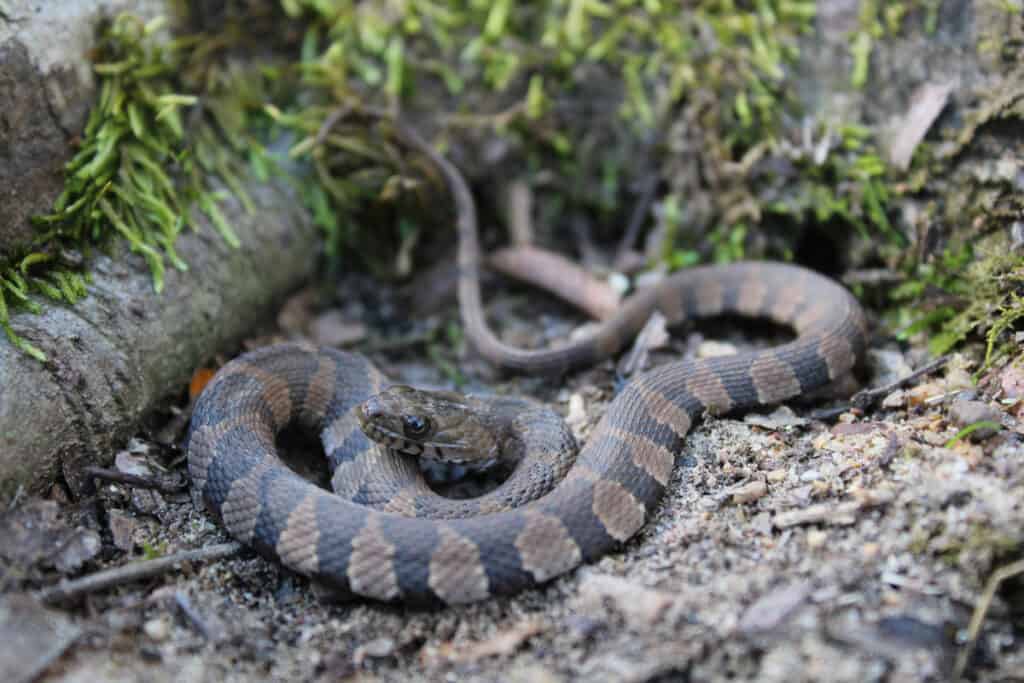
This beautiful brown and black-ringed midland water snake is native to the United States. These non-venomous snakes usually grow to be between two and three feet long, but can reach up to four feet in length!
©Tucker Heptinstall/Shutterstock.com
3. Diamond-Backed Water Snake
Scientific name: Nerodia rhombifer
The diamond-backed water snake is a relatively large, non-venomous water snake species. Adults are typically three to five feet. The snake is fairly common in the western counties in Alabama and is ranked Low Conservation Concern by the Department of Conservation and Natural Resources.
The snake is greenish-brown to brown, with dark blotches running down its back. The dark spots interconnect on the sides, forming the distinctive diamond patterns from which the snake receives its name. The pattern is more prominent in younger snakes.
The underbelly is typically yellow with dark markings. N. rhombifer has keeled scales, which gives it a rough texture. The snake prefers slow-moving or still water with dense vegetation, which provides great cover for hunting and hiding.
The diamond-backed water snake is a diurnal hunter, preferring to hunt during the day. It feeds on numerous aquatic species, including toads, tadpoles, frogs, minnows, small fish, salamanders, carrion, and crayfish.
The snake is ovoviviparous, meaning that it gives birth to live young. The adults mate in the spring, with gravid females giving birth in later summer or early fall. The typical litter size is roughly 13 to 62 offspring.
The diamond-backed water snake can be found basking on overhang branches but quickly drops into the water and swims away when approached. When cornered, the snake will hiss and flatten its head and body to appear large. It can also deliver a painful bite if physically harassed or handled.

These diamond-backed water snakes may look intimidating, but they are actually nonvenomous and harmless. With their mesmerizing patterned scales, they make for quite the sight to see in the water.
©Laurie L. Snidow/Shutterstock.com
4. Gulf Saltmarsh Snake
Scientific name: Nerodia clarkii
The gulf saltmarsh snake, also identified as bay moccasin or Clark’s water snake, is a medium-sized snake found in the Southeastern United States, including the Mobile River. Alabama’s Department of Conservation & Natural Resources classifies it as a High Concern Conservation species due to the increased destruction and degradation of its unique habitats, especially salt marshes in Baldwin and Mobile counties.
Gulf saltmarsh snakes are typically 30 inches or less, with a maximum length of 36 inches. They are the only stripped members of the genus Nerodia, with four stripes highlighting the upper parts of the body. Two stripes are typically brown, while the other two are light tan or yellowish. Their belly is darker, with a conspicuous light stripe running down the center.
The bay moccasin typically feeds on small fish, crustaceans, and other small aquatic animals, often trapped in paddles created by outgoing tides. The snake uses its strong jaws and teeth to capture and consume its prey.
Gulf saltmarsh snakes are typically active at night and hide in wrack lines and vegetation during the day. They mature at approximately three years, with the spring through early summer mating season. Females give birth to live young in late summer and can have a litter of 8-20 offspring. The young are similar in appearance to adults but are often more brightly colored.
Gulf saltmarsh snakes are non-venomous and pose no significant danger to humans. However, they can be defensive if provoked or threatened and may bite if cornered.
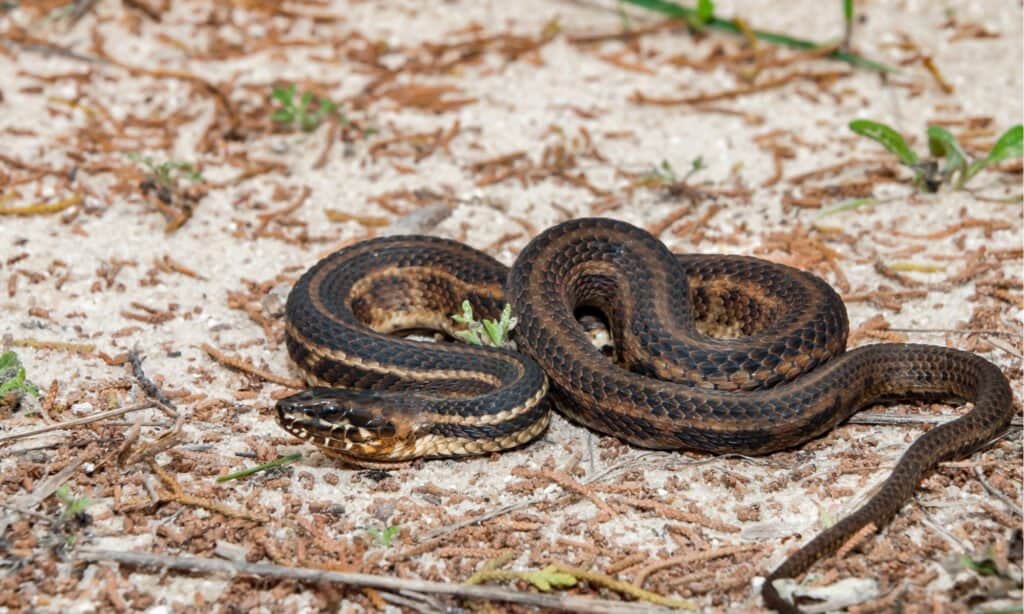
This gulf saltmarsh snake is native to coastal areas in the Southeastern United States and is known for its distinctive zigzag pattern.
©Jay Ondreicka/Shutterstock.com
5. Southern Water Snake
Scientific name: Nerodia fasciata
The southern water snake, also identified as the banded water snake, is a mostly aquatic non-venomous snake species common across the southern portion of the coastal plain. Alabama is home to a few subspecies, the Nerodia fasciata (banded water snake), Nerodia fasciata pictiventris (Florida banded water snake), and Nerodia fasciata confluens (broad-banded water snake.) The International Union for Conservation of Nature and Natural Resources (IUCN) classifies it as a least-situation species with a population pretty strong.
Southern water snakes are medium-sized, commonly less than four feet long. However, there are records of sightings of up to five feet. The snake is generally gray, greenish-brown, or brown, with a distinct pattern of alternating dark and light bands. The belly is typically lighter than the rest of the body.
It has squared reddish belly spots, which people often confuse with the cottonmouth, killing it unnecessarily. It also has a dark stripe extending from its eyes to the corners of the mouth. The southern water snake is carnivorous, feeding frogs, fish, and small birds.
The snake typically breeds in spring. Females usually produce from 9 to 50 live young after a gestation period of about 79 days. The young measure 8 to 9.5 inches. The young are independent right after birth and must fend for themselves.
The southern water snake is non-venomous and hunts by smell and through the vomeronasal organ. The snake is quick to flee from danger. However, it can inflict a painful bite when cornered or physically handled. The snake also releases a foul-smelling musk to fend off predators.

This southern water snake is enjoying the summer sunshine by soaking up some rays on a rock.
©Deborah Ferrin/Shutterstock.com
6. Cottonmouth
Scientific name: Agkistrodon piscivorus
Cottonmouth is a semi-aquatic, venomous snake native to the Southeastern United States. It occurs statewide in Alabama but is more common in the Coastal Plain swamps. It is the only venomous water snake in North America. It can be classified into three subspecies: Agkistrodon piscivorus leucostoma (western cottonmouth), Agkistrodon piscivorus piscivorus (eastern cottonmouth), and Agkistrodon conanti (Florida cottonmouth).
The cottonmouth is a large, heavy-bodied snake with a distinctively broad, flat head and a thick body. It generally has an olive, brown, or black back. It also has a white or yellowish mouth interior that is visible when it opens its jaws. Juveniles are typically brightly colored and have reddish-brown crossbands and a sulfur-coated tail.
The large, triangular heads have a dark line marking that runs through the eyes, elliptical pupils, and prominent jowls due to the venom glands. An adult cottonmouth can measure 30 to 74 inches. The scales are keeled, with large scales covering its head and in front of the eyes.
Cottonmouths are typically solitary creatures and hunt both during the day and night. Their diet includes fish, turtles, small mammals, rodents, birds, and other snakes. The snake uses its venom to strike its prey, holding them in their jaws for a few minutes, allowing the poison to take effect.
The snake prefers to live in brackish waters and can be found in most wetlands. It is ovoviviparous, with the female giving birth to 1-20 live young after an approximate three-month gestation period.
Cottonmouths are known to be aggressive and often stand their ground when threatened. They typically open their mouths wide to display the white or yellow mouth interior, hoping to scare away the attacker. If cornered or captured, the snake will bite.
The bite is highly dangerous and fatal to humans. The venom is hemotoxic, breaking down the blood cells and preventing the blood from clotting effectively. You should seek immediate medical attention if you suspect a cottonmouth bite.
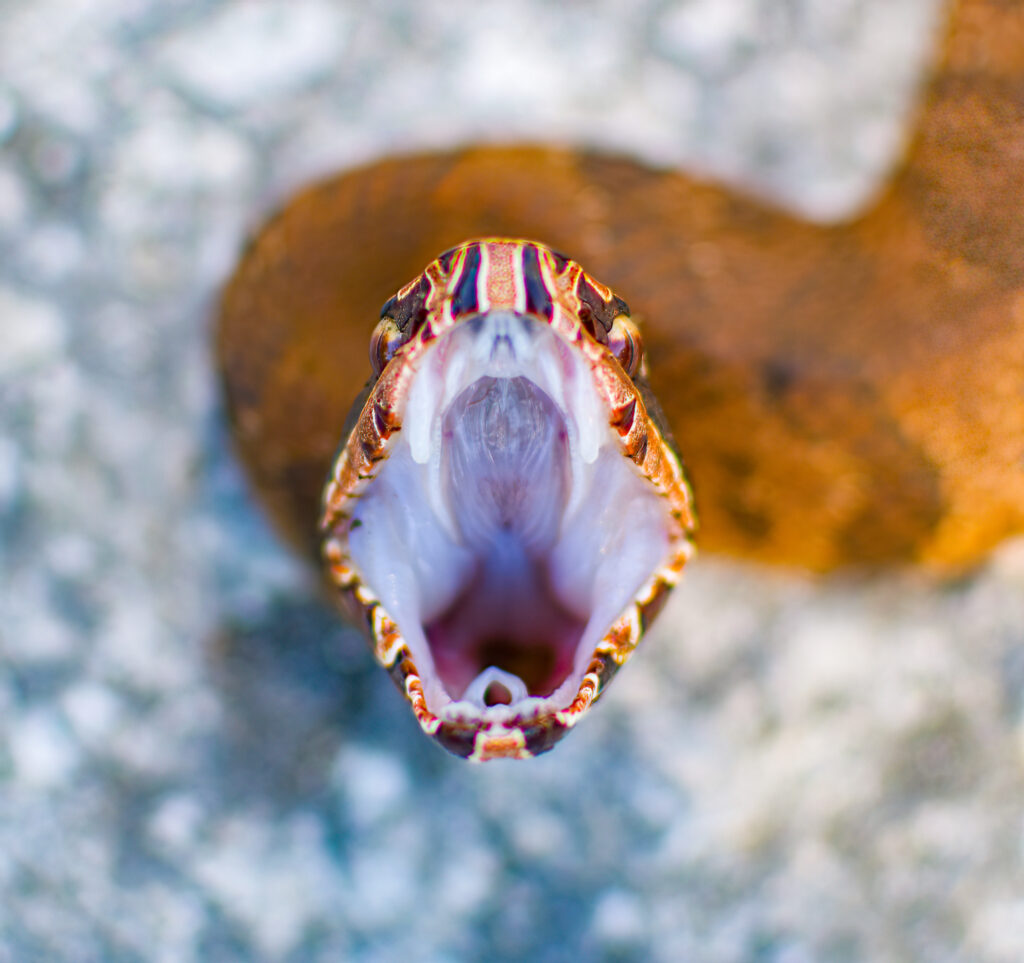
This photo captures a cottonmouth, also known as a Water Moccasin, with its mouth wide open. Be careful around these snakes; they are venomous and can strike quickly!
©iStock.com/Chase D’animulls
7. Mississippi Green Water Snake
Scientific name: Nerodia cyclopion
The Mississippi green water snake is a medium-sized, dark-colored, and heavy-bodied snake. The snake grows 20 to 45 inches long and has no distinguishing marks. It is typically green to brown with some dark pigmentation on its back. The belly has lighter spots that resemble the half moons. Its scales are keeled, and the anal scale is divided.
The snake prefers calmer waters in lakes, ponds, streams, and rivers. Its diet comprises fish, toads, crayfish, and frogs. The Mississippi green water snake mates on land in April, with offspring birthed in July or August. The offspring measure roughly ten inches, with the brood size varying from 7-101, depending on the size of the female.
The snakes are non-venomous and typically pose no threat to human or pet life. When threatened, the Mississippi green water snake will try to flee when given the opportunity. It may hiss, wag its tail or strike with a closed mouth when cornered.

Take a closer look at this beautiful Mississippi green water snake! Its vibrant green scales are mesmerizing, while its signature yellow eyes will keep you captivated.
©Jason Patrick Ross/Shutterstock.com
8. Brown Water Snake
Scientific name: Nerodia taxispilota
The brown water snake is a medium-sized snake native to the Southeastern region of the U.S. The snake is classified as a Low Conservation Concern, with the numbers fairly stable across the state.
The snake typically grows to two or three feet long, though individuals of up to four feet have been recorded. It is light to dark brown with darker blotches on its back. It also has a light-colored belly. The brown water snake has a keeled scale with large eyes that appear perched high on its head. The coloration of the juveniles is strikingly similar to that of the adults.
The snake is typically found near water bodies, particularly ones with a lot of overhanging vegetation. It also prefers slow-moving waters that help in the camouflage. The snake is an excellent climber and can be found on trees twenty feet above the ground. When startled, the excellent swimmers jump into the water and remain submerged for long periods.
The brown water snakes are carnivorous and feed on fish, salamanders, small mammals, and other snakes. They have a unique hunting strategy, hanging down from branches to strike their prey. Some lie on the surface of the water, waiting for fish to pass underneath before attacking.
During the breeding season, which occurs in the spring, males will engage in combat for an opportunity to mate with females. Females give birth to live young in the summer, typically producing litters of 10-20 offspring.
The snake is non-venomous and poses no threat to humans. It releases a foul-smelling musk when threatened. Brown water snakes can also strike their aggressors when cornered. During cold winters, the snake hibernates under rocks, logs, or burrows.
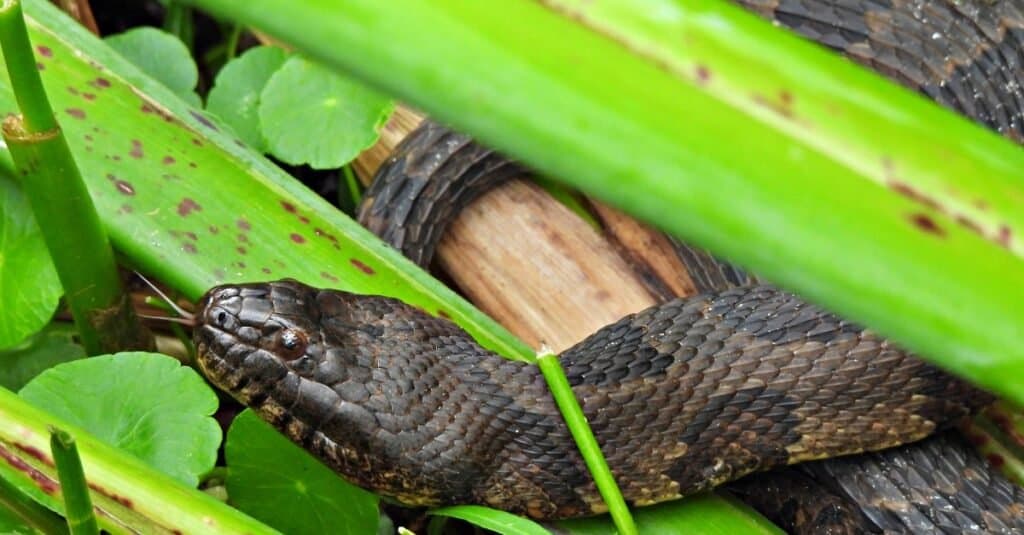
The underside of the brown water snake is yellow or cream-colored.
©iStock.com/passion4nature
Identifying The Water Snakes In Alabama’s Mobile River
Mobile River is a thriving habitat for many snake species. Each species has unique characteristics and adaptations that help them to survive in the wetlands. Most snakes in this post are non-venomous and wouldn’t pose any serious threat to you or your pets.
You may need to watch out for the cottonmouth, whose venomous bite can be fatal. This guide will help you identify the unique characteristics of these snakes and appreciate their roles in fostering biodiversity.
Summary of the 8 Snakes of Alabama’s Mobile River
| # | Snake | Danger Level |
|---|---|---|
| 1 | Plain-Bellied Water Snake | Low – avoids conflict |
| 2 | Midland Water Snake | Low – avoids conflict but is aggressive when harassed |
| 3 | Diamond-Backed Water Snake | Moderate – will deliver a painful bite if harassed or handled |
| 4 | Gulf Saltmarsh Snake | Low – avoids conflict but will bite if cornered |
| 5 | Southern Water Snake | Low – avoids conflict but will bite and emit foul-smelling musk if harassed |
| 6 | Cottonmouth | High – its hemotoxic venom is highly dangerous and can be fatal |
| 7 | Mississippi Green Water Snake | Low – avoids conflict |
| 8 | Brown Water Snake | Low – avoids conflict, may emit foul-smelling musk |
The photo featured at the top of this post is © iStock.com/lbolton09
Discover the "Monster" Snake 5X Bigger than an Anaconda
Every day A-Z Animals sends out some of the most incredible facts in the world from our free newsletter. Want to discover the 10 most beautiful snakes in the world, a "snake island" where you're never more than 3 feet from danger, or a "monster" snake 5X larger than an anaconda? Then sign up right now and you'll start receiving our daily newsletter absolutely free.
Thank you for reading! Have some feedback for us? Contact the AZ Animals editorial team.






